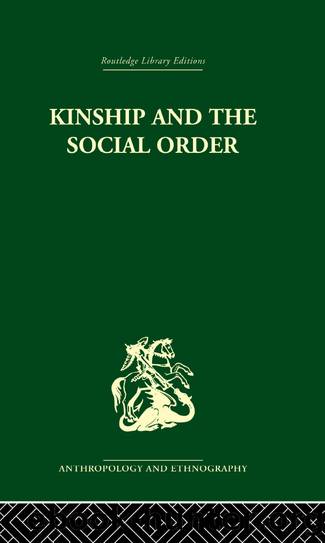Kinship and the Social Order. by Meyer Fortes

Author:Meyer Fortes [Fortes, Meyer]
Language: eng
Format: epub
ISBN: 9780415866521
Barnesnoble:
Publisher: Taylor & Francis
Published: 2013-08-28T00:00:00+00:00
XI
What then, to sum up so far, is the lineage in its maximal span? Viewed from the outside, the lineage can properly be described as a corporation aggregate, in Maineâs sense. It is a locally anchored association but not locally or territorially bounded. As such, it is a single politico-jural entity, a jural person, participating, as an indivisible segment of the political structure, in the government and ceremonial of the chiefdom through the office vested in its representative head. As such, likewise, it establishes and exclusively mediates the individualâs citizenship in the state; and as citizens, all members of a lineage are on a par with one another (sex and age being allowed for), entitled to the same rights and privileges, subject to the same duties and claims.
In this context, the significant requirements are that lineages shall be demarcated from one another by unequivocal structural boundaries, have continuity through time, and be unambiguously represented in the office of lineage head. These conditions are met by the recognition of matrilineal descent as the sole and exclusive rule for the assignment of persons to the politico-jural divisions of the community. But the same purpose could have been fulfilled by some other rule of exclusive politico-jural assignmentâa locality rule, for example, as at the village level among the Lozi or, better still, the ward level among the Tswana.76 Whether or not the lineage has an estate is irrelevant in this context.
So much for the corporate status of the lineage in the external politico-jural domain. The corporate continuity of the lineage depends, however, upon its internal structure and mechanisms of social reproduction; and here the rule of matrilineal descent operates in a different planeâas the central internally unifying organizing principle. Firstly, it uniquely and absolutely regulates the incorporation into the lineage of persons qualified by birth or adoption. Secondly, it is the basis of the structural framework within which the succession of matrifilial generations through time, and the consequential differentiation of uterine segments at a given time, are held together in exclusive, unitary, and perpetual association. It fulfills this task by virtue of being embodied in an accepted genealogical charter which validates both the unity of the lineage, as a whole, at a given time, and its internal differentiation by generation and stirp conceptualized as extended over a stretch of time. And thirdly, it is the institutional medium through which the metaphysical dogma of the perpetuity and unity of the lineage blood is translated into jural and moral process. The concept and rule of matrilineal descent serves, thus, as the crucial institutional bridge between the internal structure of the lineage and its external relations in the politico-jural domain. Lineage headshipâthe other, conceptually distinct, bridge institutionâis, from the internal point of view, partly an administrative office and partly a priestly office, contingent upon the requirements for the orderly management of lineage affairs and for the implementation of its internal corporate unity.
Descriptively and for the actor, the lineage is a genealogically demarcated association of persons of both sexes and all ages and generations.
Download
This site does not store any files on its server. We only index and link to content provided by other sites. Please contact the content providers to delete copyright contents if any and email us, we'll remove relevant links or contents immediately.
Chaco's Northern Prodigies : Salmon, Aztec, and the Ascendancy of the Middle San Juan Region after AD 1100 by Paul F. Reed(349)
Law Enforcement Interpersonal Communication and Conflict Management by Brian Douglas Fitch(345)
Digital International Relations by Unknown(340)
Critical Perspectives on Human Security : Rethinking Emancipation and Power in International Relations by David Chandler; Nik Hynek(322)
Skilled interpersonal communication: Research, theory and practice, Fifth edition by Owen Hargie(320)
The Enduring Color Line in U.S. Athletics by Krystal Beamon Chris M. Messer(317)
Evidence-Based Policy Making in Labor Economics by Hamermesh Daniel S.;Nottmeyer Olga K.;Nottmeyer Olga;King Sarah;King Sarah;King Sarah;(291)
EPSO CAST Political affairs EU policies: How to succeed in the selection procedure by Franco Reverte José María(282)
Criminological Theory in Context by John Martyn Chamberlain(264)
Writing Public Policy - A Practical Guide to Communicating in the Policy Making Process by Catherine F. Smith(263)
Tibeton Yoga Its Secret Doc by Evans-Wentz(259)
Threshold Concepts in Women's and Gender Studies by Christie Launius Holly Hassel(259)
Social Problems, Social Issues, Social Science by James Wright(256)
Positive Psychology and Spirituality in Counselling and Psychotherapy (Conflict, Ethics, and Spirituality, 12) by unknow(256)
Rothschild and Early Jewish Colonization in Palestine (Geographical Perspectives on the Human Past) by Ran Aaronsohn(255)
Play in child development and psychotherapy: toward empirically supported practice by Sandra W. Russ(248)
Cognitive Development in Infancy and Childhood (Elements in Child Development) by Mary Gauvain(245)
Latin American Politics and Society by Gerardo L. Munck & Juan Pablo Luna(217)
What Makes a Social Crisis?: The Societalization of Social Problems by Jeffrey C. Alexander(215)
